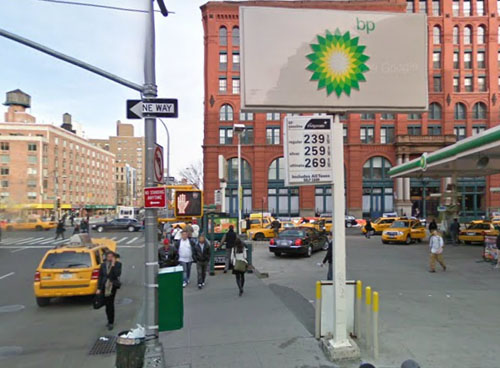Truckstop redux.
Tuesday, December 18th, 2012
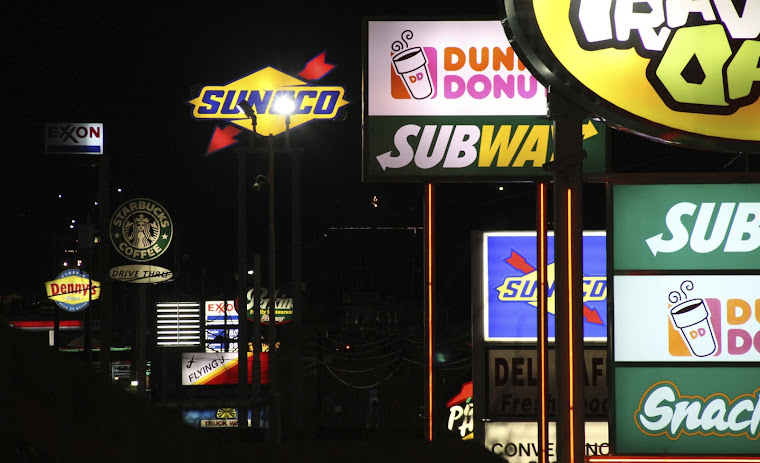


Did I mention that on our recent trip to the northeast we spent the night in Breezewood, the fabled town of one thousand motels? The midnight home of truckers aplenty? The western end of an abandoned chunk of the Pennsylvania Turnpike? And once the stopping place for transcontinental buses bound for New York that might have picked up a passenger or two in Columbus, Ohio? Yeah, that one.
Is this the new one…?
Sunday, March 25th, 2012
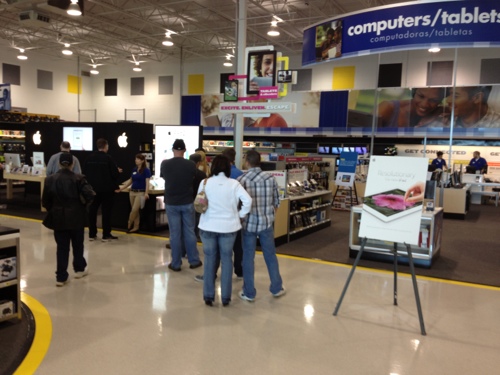
Spending a little of my time away from the hospital wandering around, and on Sunday morning I decided to wander over to one of the Best Buys—Lansing is Apple Store free. Sure enough, there was a lineup of maybe 20 folks at the door, and although that translated to a line of maybe a dozen in front of the iPad sales table, they were willing go get what they could, pretty much sight unseen…all the demo units were iPad 2s.
I guess I can see why Apple made a marketing deal with Best Buy a few years back…if this scene is being repeated in the Fort Waynes and the Springfield Ohios of the world….well, that’s a way to move quite a few of the magical tablets.
Apple pro ‘trucks’: workflow-tough?
Monday, January 16th, 2012
There’s a fair amount of consensus among the online sources I read that Apple is at least neglecting, if not outright abandoning the pro marketplace, and more specifically the world of television professionals. Today brought an Ars article entitled Why the video pros are moving away from Apple. I read reports of large production houses that used dozens of Apple’s Final Cut edit systems who are reluctantly switching to Avid—the only other viable option, they say.
I also detect a fairly healthy backbeat—voices saying that programs like Final Cut Pro X are the future, tape is the past, and that the universe of people who need truly pro-level tools to create graphics, animation, and to edit, finish, and deliver broadcast and film content is, really, get over yourselves, a niche market.
I’m not so sure. If you define “niche” in terms of raw sales numbers, you may be missing the outsized influence that edit and graphics rooms filled with Macs around the world have on the creative community.
Because those workplaces exist, there are students in schools everywhere learning Final Cut, Motion (and 3d software like Maya and Cinema 4D, and 2d essentials like Adobe’s After Effects, Photoshop, and Illustrator). They work (for the most part) on Macs. They come through a training regimen ready to walk into edit suites and design houses and create material that actually works on “real” projects.
 Video pros like to use the word “workflow” a lot, and the reason for that is simple. The stuff they make is part of a whole—the opens and graphics of a larger program, or a package that shows up within that program, or a program that fits within a stream of programming throughout a day, or a commercial or interstitial that has to bridge the gaps between programs. When you’re part of a team, you’re handed material, you work with that material, and you hand it on in a way that meets certain standards and fits in the puzzle in a predictable way.
Video pros like to use the word “workflow” a lot, and the reason for that is simple. The stuff they make is part of a whole—the opens and graphics of a larger program, or a package that shows up within that program, or a program that fits within a stream of programming throughout a day, or a commercial or interstitial that has to bridge the gaps between programs. When you’re part of a team, you’re handed material, you work with that material, and you hand it on in a way that meets certain standards and fits in the puzzle in a predictable way.
That’s being a pro. That’s being part of a team. In television-land, you may be part of a closely-knit unit of a dozen or fewer. On a film, you may be one of hundreds. The amount of raw material you work with and have to sort through is staggering. Metadata is your friend. Doing it right—frame rates, codecs, interlace, gamma—is part of the job.
Workflow is part of the job. It’s not just a “nice to have” option.
Starting a few years back, Apple was able to deliver hardware and software that made it easier to not just create content, but to do it in a way that fit into professional workflows in such a way that it made creative professionals’ lives easier.
It wasn’t just that you could make movies or television bits. You could, with these tools, make “real” stuff. Stuff that met standards. Stuff that could air without jittering or blowing out the color on your TV.
It was interesting to me that in a world increasingly filled with iDevices, Steve Jobs spun out the now well-known analogy that iPads would be more like cars with automatic transmissions, but, he said, we’ll always need trucks for the heavy lifting of content creation.
With the release of Final Cut Pro X, some in the creative community saw a slick sports car that Apple designed that, sadly, was not street-legal. Very cool, very shiny, but pros often found no way to use it to do the heavy lifting of their modern workflows.
We still need fresh new trucks, with tricked-out power and industry-leading features. At CES this month, manufacturers showed off 4K camcorders…a higher-than-high definition that makes my hard drives wobble at the knees just to contemplate.
We’ll all be editing on iPads someday? Well, if the largest iPad would only hold, say, 10 seconds of 4K video, that might be a challenge.
To do a professional job of content creation, those fresh new trucks, the 2012 models, will need:
- The fastest processors and maximum RAM, of course.
- Increasingly, the GPUs—graphics processing subsystems—need to be hugely powerful, upgradable, combinable—they’re the core of the powerplant of future content creation, if I haven’t bent a metaphor too much there. New software, from Apple and elsewhere, will rely on them more and more with each rev. You may need not one but several, working cooperatively, in one box.
- Huge flexibility in i/o options. This includes bringing things in and getting them out in almost every conceivable way, including to videotape when appropriate. Sure, Thunderbolt is a good start in that direction.
- And software, including operating system software, that works hard to keep all the bits circulating at max speed with minimum complications.
Now the nice thing, the win-win, about Apple putting energy into creating systems like these, and the key to why this is not just a niche market question, is that development success here leads to staggering improvements in all the behind the scenes slickness that makes iOS so powerful in devices. There’s no doubt that all the work spent in making type, animation, transitions, and movement work on professional content, software, and systems paid off in huge benefits when Apple wanted to bring modern design slickness, speed, and elegance to things you hold in your hand.
They have to keep that innovation in every part of the pipeline. Mac OS X has to remain, at its core, a pro-level, configurable operating system. It’s gotta run on high end boxes. And those boxes have to run a complete suite of pro-level creative software that not only serves those who must work within very particular and demanding workflows, but establishes a great test bed for the next innovations for iOS and our increasingly device-filled world.
Seems to me Apple abandons this workflow at their peril.
Michigan light.
Thursday, January 5th, 2012
I’m sitting on the futon couch in Sammy’s dad’s living room, and her dad is paging through this morning’s NY Times, which shows up at 4 am in the mailbox across the road, along with the Wall Street Journal, which Sammy’s brother Gordy is reading. Their postures are remarkably similar in the way that direct relatives are. They’re both sitting to get as much daylight from outside as possible. Although it’s cold, it’s sunny and bright, and we’re grateful for that. It just as easily could have been the dark grey cloud helmet of winter that seems to settle in here and make people’s lives, well, dim in addition to cold.
We’re here to help with the pile of mundane tasks that accompany the passing of a loved one. Sammy’s mother—Nick’s seven-decades-long wife—left the stage just as 2011 turned into 2012. The basic chores—moving, disconnecting, finding places for things— have gone well, and we’re hoping to leave things in a good place for her dad to make his personal adjustments to life more alone.
Somehow being up here in winter always puts me in the mind of beginnings and transitions. Cold, darkness, and vast, flat stretches of midwestern dormant agriculture will do that to you.
Hope your year is starting with enough light to burn off the winter doldrums.
A feeling for timelines.
Sunday, October 23rd, 2011
Ten years ago today the original iPod was introduced. (Ours is on a shelf next to a Brownie camera in our dining room.) Sixty years ago last Thursday the CBS ‘eyemark’ logo created by William Golden and taken and ran with by legendary CBS design guy Lou Dorfsman was introduced. (Dorfsman’s book about his CBS design career is in our downstairs bathroom.) Nine days ago the newest iPhone, the 4S, became available for sale in the US (and a handful of other countries…we watched the rain-soaked first adopters outside the Apple Store in downtown Montréal.) Four years ago last Wednesday Sammy and I were in “our” Apple Store picking out her desktop machine, which in some ways still looks and “feels” new. In 1999 on October 23rd we were in CompUSA (where? wha?) picking out her blue-and-white G3 desktop, which is…well, I have no idea what happened to it. That day “feels” as if it’s long, long ago. But our data stream reports we had sushi with Bill, Morgan, and Miranda after picking up the machine.
I can string all this data out on a timeline and it still doesn’t “feel” like a linear progression that makes any kind of sense. It’s more like a half-hearted attempt to line up Billy Pilgrim’s unstuck jumbled bullet points of an existence. Our modern digital devices say we were here, or there, at discrete moments. On this day in 1992, we were in Little Rock Arkansas, and while archaeologists met, Bill Clinton’s war room moved him closer to the White House in rented space just down the street from our hotel. We saw Jim Carville in the bar. The next day, we’ll eat at a Hunan restaurant in Benton, Arkansas. Last year on October 23rd we went to Trader Joe’s and spent $39.27. Some of that on chocolate-covered almonds, I don’t know.
And a year or two from now, I can pull out my phone and ask “Siri, where was I on this day in 1977?”
And it’ll still feel completely abstract.
Squint.
Wednesday, September 14th, 2011
I’m not sure whether I’m squinting because it’s late, or whether my allergies are kicking up or because I’m squinting with skepticism at the idea of writing in this dusty old journal. Probably it’s all of the above.
My sister visited over the weekend, and it was great to see her. When last we saw her, she had graduated law school and had the sword of passing the bar over her head. Well, she has earned that ‘Mission accomplished’ banner, and now, as she visits, I’m aware that she’s simply a lawyer, without disclaimers or asterisks. She’s for real. We celebrate that.
And somewhere in there America commemorated a holiday that is easily the most…well, maybe this is what it felt like to commemorate Pearl Harbor just a handful of years after the event. We did a lot of our commemorating by averting our eyes from the pre-edited pre-digested media presentation of the anniversary. It happened. It’s a while ago now. We go on.
And now, the day after my sister’s visit, I got up early with Sammy and dove deeply into work, crafting layers of (as it turns out) rendered PNGs and animate sequences and making type sizes hit nice even round numbers and, well, it’s the work of a designer. And it felt good to get a lot done.
But now, I’m pretty sure that it’s just late. So I think I’ll go rest my eyes.
Dear nice Swiss tourists…
Friday, May 27th, 2011
Sammy and I enjoyed talking to you at Segesta the other day. Remarkable that you remembered having seen us before at Selinunte, specifically, you remembered Sammy from her somewhat distinctive hat.
We were once again struck by the language skills of so many we encounter in Europe. We have trouble crafting a sentence in English sometimes and you’re able to communicate in our language and apparently several others. And we were delighted to hear that you had visited the United States in the past and had wandered from Niagara Falls out to Arizona. I had to tell you that I had only briefly visited one tiny part of Switzerland. The places you mentioned sounded quite beautiful and I hope we get there sometime.
And when you told us that it would be much harder to choose to visit the US nowadays because our government treats people entering our country like criminals, well, I realized immediately what you were saying and, out of embarrassment for the choices our leaders have made and out of embarrassment for the choices the American people have made in choosing leaders, I apologized profusely.
No amount of terrorist threat, real or imagined, justifies a government that treats its visitors—and its citizens—as suspects first and human beings second. I kept wanting to somehow explain that once you get past the Orwellian paranoia of government, the American people are a fairly decent lot, but of course if you can’t get into the country without being searched, scanned, queried, and probed it’s hard to experience that hospitality.
So, again, sorry. And maybe we’ll be able to dig ourselves out from the pile of scanners and security cameras and secret laws and offer a warm welcome to the rest of the world that matches our beliefs and best traditions.
Traveling colors.
Sunday, May 8th, 2011
Sammy tells me that we are looking out from this lovely balcony at the Tyrrhenian Sea. I can tell you it is a calm vastness of water, a blue that would be at home painted on the walls of our Virginia Highland home, and it extends to a soft, defocused horizon.
Our home here for two days, perched on a steep hillside, is a collection of terra-cotta tile colors, stonework old and new, and soft canvas awnings that, taken together says style and comfort and hey, sip some coffee and be contemplative.
So, OK, sure.
Unlike the busy seaways over by the Amalfi coast and between the Punto de Campanella and the island of Capri, these waters seem to be punctuated by just a tiny white fishing boat or two, maybe that’s a sailboat with masts down off in the distance. Still, somehow, you get the sense that the sea is a workplace, a superhighway, a playground.
If I mention that three italian donkeys—Asini in Italian—(Equus asinus domesticus)—are watching me type this, do their shades of cocoa brown and hay-brown add color to the scene, or muddy the picture?
The problem with writing about any of this is as soon as you drop in place names like those, you end up with what sounds like Mythical Typical Travel Writing, an attempt to string phrases as lyrical as the placenames they connect. And if you find yourself hearing your words in your head narrated by Robin Leach, stop, you’ve definitely done something horribly wrong.
So maybe I should practice a bit.
Echoes of protest and repression.
Thursday, February 3rd, 2011
I’m going to sleep after watching dawn rise over Cairo through live internet feeds from Al-Jazeera, MSNBC, and CNN. (As it turns midnight on the U.S. east coast.) Tanks. Tear gas. Molotov cocktails. Protest. Fear. Rumor. Machinations behind the scenes. Incredulity.
Very nervous about what today will bring to the good people of Egypt. Kinda fearful that if we won’t—or can’t—watch, very bad things will happen.
I look at this faraway square in Cairo.
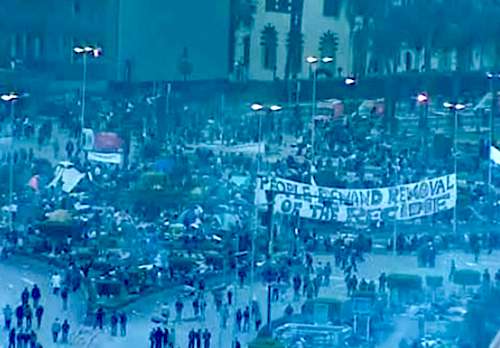
I think back to another distant square, 22 years ago.

And I think back much further to an Ohio campus square, 41 years ago.

We can look on, listen in, and twitter amongst ourselves and the world community about this pivotal event in the history of a country and its people better than at any time in history. Does it make a difference to their fate, in the face of a gun barrel?
Scanned past.
Monday, January 24th, 2011
At my sister’s behest, I’ve been scanning a large collection of old images from our family. And at this rate, I should have them done sometime in 2017, so, hey, that’s progress. Came across a badly crinkled old black and white contact sheet from my stay in the fall of 1974 in New York’s East Village (I returned some filmmaking equipment for some friends—on the Greyhound—and spent a while living by myself at their Crosby Street loft, which was then a new term to me.)
At any rate, here’s one of the images:
And it didn’t take more than 20 seconds of messing with Google Maps and Google Street View to line it up with the near-present:
This is (and I didn’t know this back in 1974, because my online search capabilities were a bit more limited then) a view toward the The Puck Building, which Wiki-p tells me is “an example of Romanesque Revival architecture”, and during the 1980s was the home of Spy magazine, which I faithfully read, even though their use of tiny type surely led me to my squinty early adoption of reading glasses.
Back in 74, this rust-colored historic place housed a printing ink manufacturer, and in fact I remember the rich smells of toxic ink formulations that wafted down Houston from that fine Romanesque whatever-you-said-it-was architecture. And the smells mixed with the Gulf (hm, now BP) gas station to provide a wonderful urban bouquet in Abe Beame’s New York City.
I’m hoping I can find the negatives from these long-ago pix in all of this mess, but these crinkly scans might have to do.
Target audience.
Wednesday, January 12th, 2011
Yeah, I thought this was a great example of using design as a political statement:
As reported in Salon, this cover, designed apparently by Dan Savage and Aaron Huffman, reminds us of the power of symbols and the impact of the gun on politics—and personal freedom—on American history.
I’m aghast at the machinations of the Palin/Beck block to try and spin this into something of an attack on right-wing political speech; they attempt to conjure a world where people on the left use the same violent, final terminology as they do. Doesn’t happen. When the very malevolent Roger Ailes has to say “tone it down, guys,” and “make your arguments intellectually,” something has really gone off the rails. They may be so far down the track from the intellectual components of their political arguments that they’ve forgotten how to do that, Roger.
Symbolic.
Monday, January 10th, 2011
 This, I think, means ‘go ahead and read your iPhone in the shower.’ (From The Noun Project.)
This, I think, means ‘go ahead and read your iPhone in the shower.’ (From The Noun Project.)
Hello there from our frozen city, which is suffering through what in most places would count as a minor snow event, but here, we’re attempting to attach apocalyptic terms, but for some reason, they’re just not uh…sticking. I might post a few pictures later, but for now, enjoy this one from last night, as we returned from Buckhead and the snow was really coming down at an impressive rate, for a while.
Backing it up at the beginning.
Saturday, January 8th, 2011
A quiet saturday afternoon in the new year, and I’m sitting here savoring the back-room sunlight watching the winds pick up as we contemplate the threat of another city-paralyzing snow + freezing rain + ice event here in a part of the country that seems highly unprepared for even the mildest of winter weather calamities.
Our plans are to travel the very few miles up to my dad’s house tomorrow evening with a carefully-crafted portable Sammy dinner, but I guess we’ll have to see if that will involve firing up the four-wheel-drive vehicle and creeping back here as the aforementioned storm gets underway (it’s supposed to get bad after dark Sunday night.) Ah, adventures of the winter kind.
Otherwise, it’s been a mercifully quiet week or so after the start of 2011, and we’ve been fairly diligent about taking care of loose ends, small chores, financial recordkeeping, and so on, mixed in with the usual array of tech support questions I find myself fielding from family and friends.
I’m conscious during these arbitrary calendar boundary crossings that it’s a good time to make sure that our various digital assets are being backed up, preserved somehow the way one might expect.
![]() So earlier this week I went out for a run to the twin mega tech merchants of Gwinnett County—MicroCenter and Fry’s—with my brother, mostly to offer moral support for his purchases, but damned if I didn’t end up buying one more 2 TB drive to, well, pile stuff onto. I mean, what future visionary could have possibly imagined that a mere $89 would give me yet another another gigantic data landfill, a virtual blimp hanger of unused space to pile stuff into/onto?
So earlier this week I went out for a run to the twin mega tech merchants of Gwinnett County—MicroCenter and Fry’s—with my brother, mostly to offer moral support for his purchases, but damned if I didn’t end up buying one more 2 TB drive to, well, pile stuff onto. I mean, what future visionary could have possibly imagined that a mere $89 would give me yet another another gigantic data landfill, a virtual blimp hanger of unused space to pile stuff into/onto?
Yeah, if I do have a weakness for impulse purchases, it tends to be in this category. It’s probably much worse that I’ve lived through the entire progression of computer storage from the early days where a megabyte or two cost more than a house—so just forget it—through the early 1980s where I was willing to pay thousands of dollars for a 20 megabyte hard drive (thousands. of. dollars.) to the present where bits live throughout our cluttered home in little silver boxes, just waiting to disappoint me with a random data failure in the future, when I call upon the device to work its archival magic.
It really doesn’t help that the size of my average television project—the raw materials used in making a station package, let alone all the bits and pieces needed for a 3D NFL football game, way, way exceed the capacity of a standard DVD-R (4.7 GB)….and really, they take up more room than a BluRay disk, which is a tech that, nah, I’m not going to invest in.
So it’s big hard drives, which are dirt cheap. That is, unless I am concerned about the drives moving parts over the long run, and instead want to pick up a bunch of flash memory (hey, no moving parts!), which at the moment is, at best, $25 for 16 GB of storage.
And of course, there’s always “the cloud,” which, in theory, is infinite, but in the real world has its own very real costs and risks as well as the costs in time it takes to push all this stuff to and from wherever “there” is.
Which brings me full circle to the mental exercise that really underlies all of this: how much of this exercise is just plain hoarding behavior in high tech clothing? Am I really going to need that background for that station in Birmingham from years ago that has probably moved on to some other perishable design?
Bit of a ponderable, if you’ll pardon the pun.
Autumnal recharge.
Tuesday, September 14th, 2010
I’m sitting here watching sunlight drift into Sammy’s family’s Green Cottage in between moments of solar hide and seek in the abundant clouds over Big Manistique Lake. We’re listening to a scratchy FM radio signal and we have internet-via-iPhone, which means that the MacBook and iPad sit here sullenly with light grey wifi logos, craving packets, while the walled garden of the iPhone, as long as we hold it close to the south windows, serves as our tenuous gateway to the more connected world in a place where, most of the time, we’re comfortable not being all that connected.
I am happily recharging and resetting after my August of mostly nonstop work. On a tight deadline, I cranked out graphics in stereoscopic 3D for the first NFL football game to be broadcast in a way that, hey “the players come out right at you,” and, uh, you have to buy a really overpriced TV and still wear silly glasses.
As a design exercise it was a lot of fun and made me even more aware of the delicate dances of 3d coordinate systems as they contribute to what we call vision, seeing, and dimension.
But now, it’s nice to look at the world not through any kind of colored or polarized or shuttered glasses and just sorta enjoy the autumnal light, growing color (those maple trees are reddening nicely) and reset my visual context to something outside of safe title markers and render queues.
Current tools of my trade.
Tuesday, August 24th, 2010
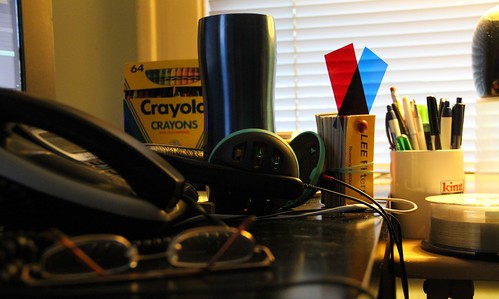
See that Lee Filter pack with the rubber band? Very important.
I’ll say.
Thursday, August 19th, 2010

Hi, just checking in from the other side of the screen. I keep composing well-thought-out essay-length things in my head, but then my day job (is that what it is?) distracts me from actually flowing them into this site.
As many of you know, I’ve been working pretty much nonstop on a complete graphics package for a preseason NFL game, which wouldn’t be such a big deal except that this one’s in 3D. As in, yeah, dimensional. Stereoscopic.
So please excuse me while I get back to massive piles of left eye, right eye graphics that have to be designed well enough so as not to give people headaches. Not since my 1981 Braves Baseball open (aka ‘Disco Baseball from Outer Space’) have I had the health concerns of my viewers be a factor in design.
Me, I pump the coffee and ibuprofen.


